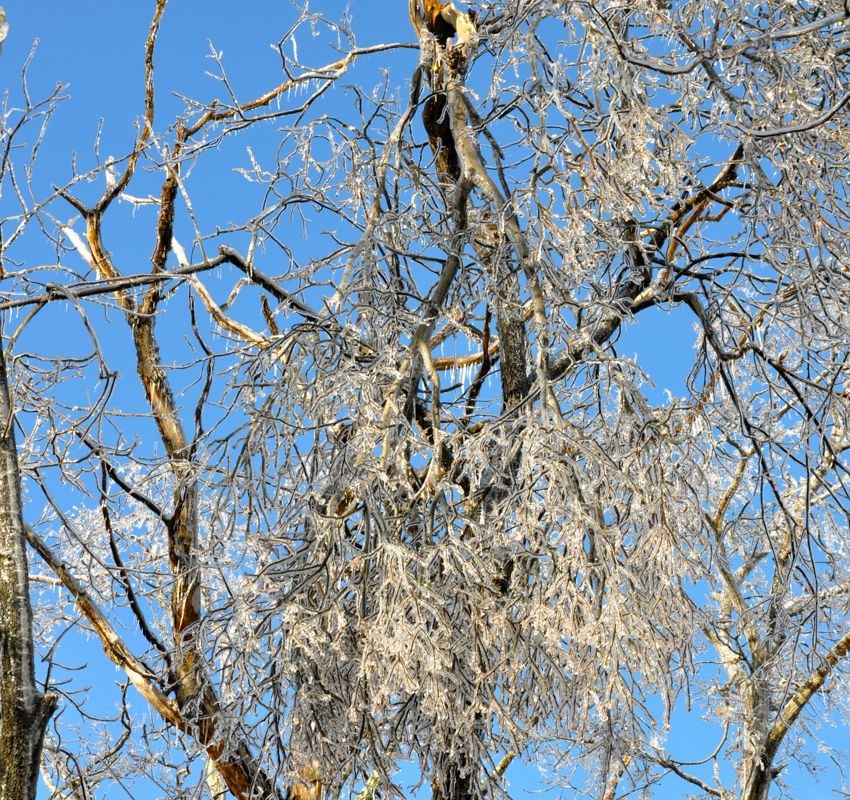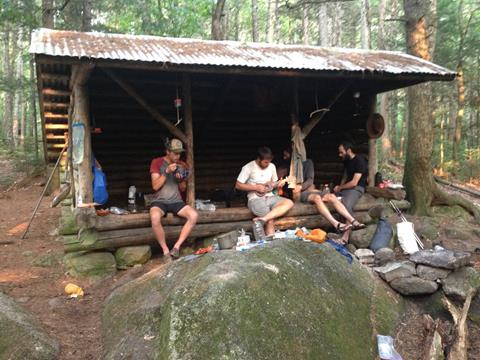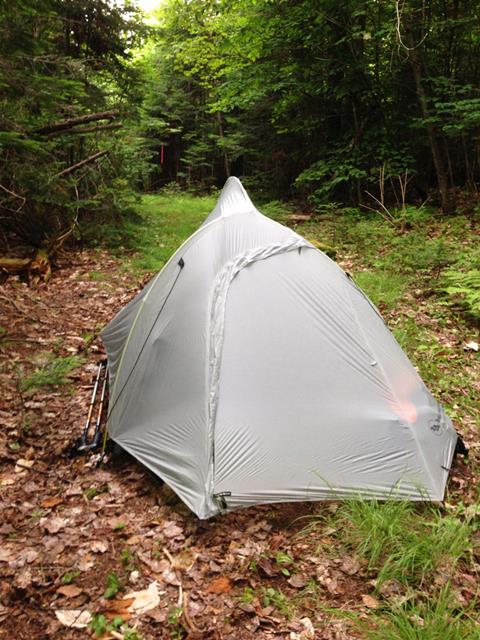Plan and Prepare
Campsite Selection: The Secret to Happy Campers
November 2, 2024
When people think about backpacking the Appalachian Trail (A.T.), they are most likely thinking about views from mountain summits or trekking through the Green Tunnel. In reality, those things take up about 50% of your backpacking experience. The other 50% will be spent at your campsite, and that makes preparing your camping and sleeping setup super important for maximizing your enjoyment and safety, and for reducing your impacts to the Trail.

Look up!
Always remember to look up before choosing a campsite to check for dangerous snagged branches, standing dead trees, and otherwise damaged/diseased standing trees. Always choose a campsite that is not within the fall zone of these hazards.
Standing trees in areas damaged by Hurricane Helene (Davenport Gap to around the New River at Pearisburg, VA) are especially dangerous and will continue to fall. Due to the fields of downed trees, finding a campsite will also be very difficult.
This tree’s crown was snapped during an ice storm, leaving a dangerous “widow maker.” Never camp under damaged trees like this one.


Russel Field Shelter. Photo by Brent Farmer.
Staying at Shelters and Designated Campsites
One of the most iconic parts of the A.T. is its system of backcountry shelters. There are more than 250 shelters along the Trail, providing hikers a destination to rest, regroup, and meet fellow adventurers (even if they choose to camp outside of the shelters at a designated tenting spot).
As you plan your destinations at the end of your hiking day, keep in mind that shelters and designated campsites are shared spaces on public land. Shelters are not private huts, party spots, or meant to be monopolized by large groups. Along with practicing Leave No Trace, hikers should follow these ten shelter etiquette tips:

- Almost all shelters on the A.T. are filled on a first-come, first-served basis (with the exception being the shelters in Great Smoky Mountains National Park). Always carry a reliable personal shelter in case an A.T. shelter is full by the time you reach camp.
- Smoke/vape away from shelters and privies.
- Make room for other hikers. Concentrate your gear into a small space and don’t set up tents or hammocks in shelters.
- If you are backpacking with a dog, please tent. Not everyone will want to share the shelter with four-legged friends. Also, please keep your dog leashed at all times.
- If you snore, sleep in your tent — everyone at the campsite will thank you.

- Make phone calls away from the shelter and use headphones or earbuds to enjoy music.
- Don’t tag (graffiti) the shelter. Express yourself and get artistic in the shelter register.

They might be cute, but shelter mice can be a nuisance and transmit disease. Photo by Christian Jobst.
- Check A.T. campfire regulations before starting a campfire. If a campfire is permitted, use only existing fire pits, burn only dead and downed wood, and ensure the fire is completely out and cool to the touch before leaving. Never leave campfires unattended.
- Don’t leave or burn trash or food scraps in the fire pit, and don’t leave extra food in the shelter, in any storage boxes, or hanging from trees. This attracts wildlife and habituates them to approaching shelters and campsites.
- Sweep out the shelter when you arrive and leave, as even the smallest crumbs can attract rodents.
All shelter etiquette boils down to common courtesy in a very small, shared space. Help others have an amazing Trail experience, too!
Dispersed Camping
Known by many as “stealth” camping, this is when hikers select their own campsite along the Trail rather than staying at shelters or designated campsites. Dispersed camping requires more time and effort to find a comfortable and low-impact site, but it can offer more solitude. Check local regulations for where dispersed camping is permitted along the Trail. To protect the Trail, dispersed camping is only allowed on about half of the A.T.
Here are tips for selecting a Leave No Trace-friendly dispersed camping site:
 Find a relatively flat spot well away from the Trail, at least 70 big steps. Ideally, dispersed campsites are not visible from the Trail.
Find a relatively flat spot well away from the Trail, at least 70 big steps. Ideally, dispersed campsites are not visible from the Trail.- Make sure your campsite is 200 feet from water sources.
- Avoid spots near trees with dangling limbs or leaning dead, diseased, or storm-damaged trees (aka hazard trees).
- Choose a durable surface that either does not show signs of past use or has already been heavily used. Avoid sites that are just beginning to show use — leave those to regrow.
Proper dispersed camping takes a high level of Leave No Trace skill. Be prepared to put in the work to make sure your stealth site can return to its natural state.
Hammock Camping
Tired of sleeping on the ground? Check out our video featuring tips for hanging a hammock on your A.T. camping trip.
Help Care for the Trail
No matter where you camp along the A.T., practice Leave No Trace principles to minimize impacts on the Trail and on other hikers.
 Camp on durable surfaces (rock, bare soil, grass, or tent platforms). Avoid campsites that are just beginning to show signs of use.
Camp on durable surfaces (rock, bare soil, grass, or tent platforms). Avoid campsites that are just beginning to show signs of use.- Dispose of waste liquids or greywater at least 100 feet from the shelters and campsites, and 200 feet from water sources.
- If a shelter has a privy and it is open, use it. Put only human waste and toilet paper in privies — pack out any trash and personal hygiene products. If there is not a privy, dig a cathole using a trowel roughly 200 feet from shelter and tent sites (6-8″ deep, 5″ wide).
- Do not cut down live trees, dig trenches or build structures.
- Practice campfire safety by knowing how to build a campfire responsibly or foregoing a fire if possible, by using a backpacking stove for cooking.
- Eat at least 200 feet from shelters and campsites, pack out all trash and food waste, and use proper food storage.
- Be respectful of everyone you meet along the A.T. so everyone can have a wonderful experience.
Catch up on our hiker preparation series
Preparing for your A.T. Hike: We’ve put together a series of tips and guides to help you plan and prepare for your next visit to the Trail, whether it’s an overnight hike or all 2,100+ miles of the A.T.
Applying Leave No Trace to Hiking Adventures: By packing out trash, camping and traveling on durable services, and respecting wildlife, visitors can help protect and preserve the A.T. hiking experience for everyone.
Don’t Feed the Bears: Before hitting the Trail this year, learn about proper food storage methods that will not only help protect your food but also help prevent negative encounters with bears and other wildlife.
Have questions about preparing for your upcoming hike? Submit a question to us directly at appalachiantrail.org/contact.
Every hiker has the chance to help steward the Trail by practicing Leave No Trace principles, which includes camping at designated campsites and on durable surfaces. Thank you for doing your part to help to preserve the A.T. and strengthen the Trail community!
